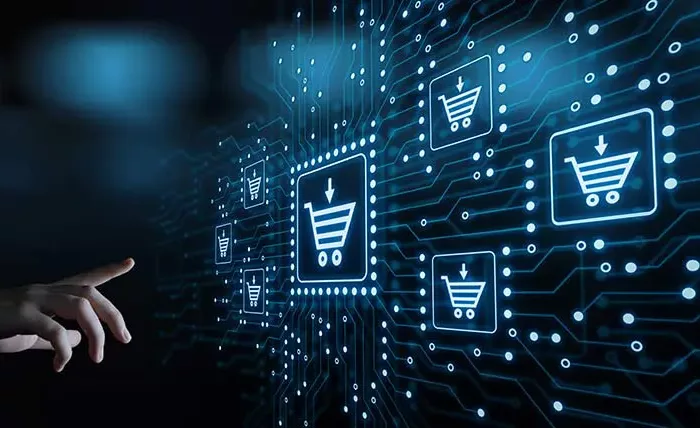Share
Author
George Anderson
Share
When you’re calculating B2B ecommerce ROI, it’s not enough to look at the simple cost of the solution and the revenue it generates. These are key components in the calculation, but they’re not the whole story.
In fact, some of the most significant factors in ROI are difficult to measure. Things like cross-channel assists and technical debt avoided—how do you quantify them?
Hence the term “dark ROI.” Like dark matter, these ROI factors play a significant role in the overall health of your B2B ecommerce program, yet they’re notoriously difficult to detect and measure.
Before we dive in, a caveat: Not all B2B ecommerce solutions can provide the comprehensive “dark ROI” that we discuss below. To realize all of this value, you’ll need a managed, cloud-hosted solution that includes prebuilt integration to SAP ERP (whether ECC or S/4HANA).
Here are the top factors in dark ROI for managed, ERP-integrated solutions.
Customer retention in the digital age
Here’s a surprising statistic: 85% of B2B buyers will abandon a supplier with a low-quality digital experience (Avionos B2B Buyer Report).
This is a challenging trend for organizations that don’t offer online purchasing through B2B ecommerce. If customers are still placing orders through phone, fax, and email, then evolving buyer preferences may begin to show up in lost revenue and reduced order volume from known accounts.
If you’re adding B2B ecommerce as a new channel, you’ll want to look at revenue holistically to see the ROI that B2B ecommerce is delivering. You’ll also want to track customer engagement and frequency of ordering to see the impact of B2B ecommerce.
Cross-channel “assists”
Here’s a fascinating question. Do EDI customers really want to send an EDI 846 to get current inventory levels?
How about an EDI 832 to get a catalog with their contract pricing?
Perhaps EDI order placement is mandated by management at the customer organization. But for individuals who are checking stock levels and building orders, self-service is far more convenient—and a B2B ecommerce solution provides it, as long as it shows real-time data from your SAP ERP system.
Now, does this really factor into B2B ecommerce ROI?
Absolutely. Consider the EDI customer who checks availability and finds out that you have far more units in stock than they expected. The customer can now place a larger order through EDI. The sale gets registered as an EDI order, but it never would’ve been that big without B2B ecommerce providing total transparency through self-service.
This isn’t only true of EDI. B2B ecommerce empowers customers to learn about products on any device, which means they’re better educated when they go to place an order by phone, in person with their sales rep, or however they make purchases. Transparency builds trust, which plays directly into the customer retention that we discussed above.
Customer service effort saved
Here’s where that real-time integration to SAP ERP really shines.
Without that integration, your B2B ecommerce experience can display only orders, shipments, invoices, and payments for B2B ecommerce orders. It can’t show any information for orders from other channels.
But if B2B ecommerce does include deep, real-time SAP integration, it can show orders, invoices, shipments, and payments for orders from all channels—plus credit status for the account as a whole.
When your B2B ecommerce solution provides this much comprehensive information, customers get everything they need at their fingertips. They don’t have to call customer service to check on a shipment, confirm their credit status, or verify what products they’ve already ordered. They can do it all through the B2B ecommerce portal, on any device.
IT cost and workload saved
If your B2B ecommerce solution 1) isn’t managed, and 2) doesn’t include prebuilt integration to your SAP ERP system, then you’re going to need dedicated IT resources to troubleshoot, upgrade, and maintain your architecture.
This is a significant expenditure, especially as your B2B ecommerce solution and your ERP continue to age. Updates, patches, bug fixes, and configuration changes all contribute to the cost of integrated B2B ecommerce—and they’re difficult to predict when you’re calculating ROI for the purposes of choosing a solution.
Here’s another area where a prebuilt ERP integration really shines. You’ve already invested millions of dollars and tons of IT effort in building and maintaining SAP ERP. This system serves as “one true truth” for your business data and logic.
If you could leverage that massive investment for B2B ecommerce, why wouldn’t you?
This approach allows IT to go on doing what they do best—supporting the business by maintaining SAP ERP. It also means that whatever value IT builds into SAP ERP, that data and logic is automatically reflected in the B2B ecommerce experience—no extra effort required.
The cost savings here are difficult to quantify. On an alternative architecture, every configuration change will require adjustments in three total systems (SAP, middleware or integration solution, and B2B ecommerce). Troubleshooting failed batch jobs and getting all three systems to play nicely is no small feat—and it will absolutely impact the overall ROI from B2B ecommerce.
Technical debt avoided
As you can see, complex architecture impacts more than just IT workload. Over the long haul, it can turn into a real liability for the organization, as it incurs technical debt. The growing cost of maintaining a “spaghettiware” solution, coupled with the institutional knowledge required to do so, can put an organization in a very bad place.
Unfortunately, architectural issues can easily become customer experience issues. Problems like a lack of real-time pricing and availability can undermine your customer experience. (Remember that stat about 85% of B2B buyers abandoning suppliers with bad experiences.) If customers can’t get personalized pricing and real-time stock availability in B2B ecommerce, that leaves a bad taste in their mouth. Even if they don’t jump to the competition, they’ve had a frustrating experience—and it costs you more to fulfill the order through phone or email interaction.
As you can see, technical debt isn’t just an IT issue. It’s a customer experience issue.
And that’s one component of dark ROI that’s difficult to realize without a built-in ERP integration.
The takeaway: Look at the whole picture in ROI
Hard data is the backbone of any ROI calculation. Without it, you’re swimming in the dark. But hard data also isn’t enough. When you examine these soft ROI components, you can build a holistic picture of what B2B ecommerce can do for your organization. The key is to bring both sides of the ROI picture to the table.
Want to become Easier To Do Business With?
Check out the Corevist Platform.
Managed B2B portals and eCommerce with prebuilt integration for ECC and S/4HANA.










